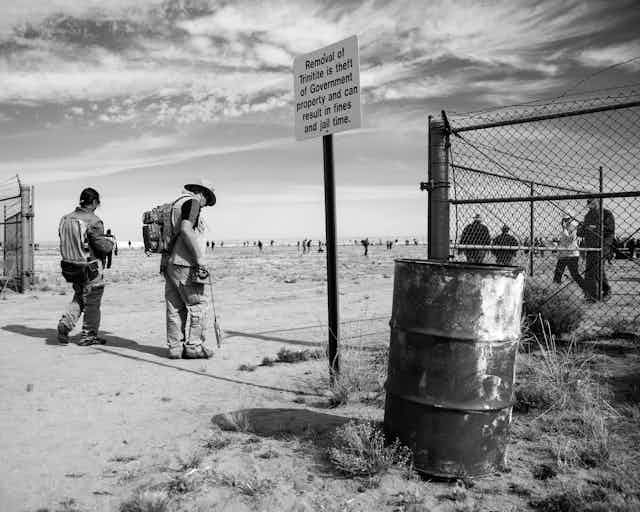Christopher Nolan’s 2023 film Oppenheimer is a biopic about the theoretical physicist behind the atomic bomb. After watching the film, I was inspired to write about my visit to the actual Trinity Site, where the first atomic bomb was detonated.
As part of my research on nuclear weapons and civil defence, I visited the Trinity Site in 2015. Located in the desert in the southwest United States, the Trinity Site is isolated, peculiar and disconcertingly mundane.
The tower that held the bomb is featured prominently in the Oppenheimer film. A small fragment of it exists today, as the rest of it was vaporized. It was deeply unnerving being near the remainder of the vaporized tower.
Arriving at the site
The Trinity Site is open to the public for only a few hours twice a year, by permission of the U.S. Army. The predicted popularity of Oppenheimer’s release will possibly overcrowd the next open house on Oct. 21.
When I visited the site, I first had to make my way to a very remote area of the New Mexico desert. Arrival had to be well before sunrise to have any chance of being in the small group of persons granted entry.
Then, after waiting for hours at the secluded gate of an active missile and munitions testing range, I had to pass the rigour of a screening at an army checkpoint and closely adhere to a given set of rules and regulations verbatim. Our convoy, escorted by military police, then went to a more remote interior location of the missile testing range.
We stopped at a barren plain in the Jornada del Muerto — “dead man’s journey” — desert.
I then walked a half kilometre along a dirt path leading to the crater. A chain-link fence distinguishes the area surrounding the crater from the rest of the desert. The blast crater is flatter than it is concave. The fence is demarcated with black and yellow signs reading “Caution Radioactive Materials.”

Visiting the site
The main attraction at the Trinity Site is a simple obelisk made of volcanic rocks marking Ground Zero. It was erected in 1965.
Adjacent to the obelisk, small fragments of the tower remained. In the distance, a low white structure shielded portions of the crater. Green glassy radioactive rocks, known as Trinitite litter the ground.
There are very few elements of interpretive information like what one would see at a museum. Military personnel dragged out a replica of the Fat Man bomb dropped on Nagasaki in 1945. It served to occupy the attention of most visitors, who perhaps anticipated more to see and do.
Vaporized tower
The most significant observation I made at the Trinity Site was a small fragment of metal in the ground. It was a fragment of the tower, and proof of physicist Albert Einstein’s theory that mass is just a concentrated form of energy. And mass can turn to energy under the conditions of an atom bomb detonation.
Einstein’s famous equation E=mc² explains the energy released in an atomic bomb, but did not explain how to build one. Einstein and Oppenheimer were colleagues, and the task of developing the atomic bomb was designated to Oppenheimer and his crew.
The Trinity Test demonstrated that humankind could tap the essence of the sun. The bomb worked, creating temperatures hotter than the sun’s 15 million degrees Celsius core. Hot gas radiated its energy in the form of x-rays, which heated the surrounding air, annihilating everything in their path. The phenomenon created a nuclear fireball.
The tower that held the bomb last existed at 5:28 a.m. on July 16, 1945. It was no longer in existence at 5:29 a.m., at the time the Trinity Test commenced. The test vaporized the experimental structure, leaving behind a crater about 1.4 metres deep and 80 metres wide.

Entertainment from horror
Oppenheimer is the latest film that explores the history of the atomic bomb. Other films go beyond this summer’s blockbuster to depict the full horror of what Oppenheimer created.
Jon Else’s 1981 documentary, The Day After Trinity, shows the real history behind Nolan’s Oppenheimer. The 1983 made-for-TV movie, The Day After, dared to show the uncomfortable images of nuclear Armageddon to American audiences. And Mick Jackson’s 1984 British television show Threads is one of the scariest depictions of nuclear war.
Watching the fake tower at the set of the Trinity Site being vaporized in the Oppenheimer film’s version of the first atom bomb explosion is stunning. Especially in 70-millimetre IMAX screenings of the film.
Seeing the fragments of the real vaporized tower in the midst of a radioactive crater strewn with green glass rocks at the real Trinity Site was a bewildering and sobering experience.

